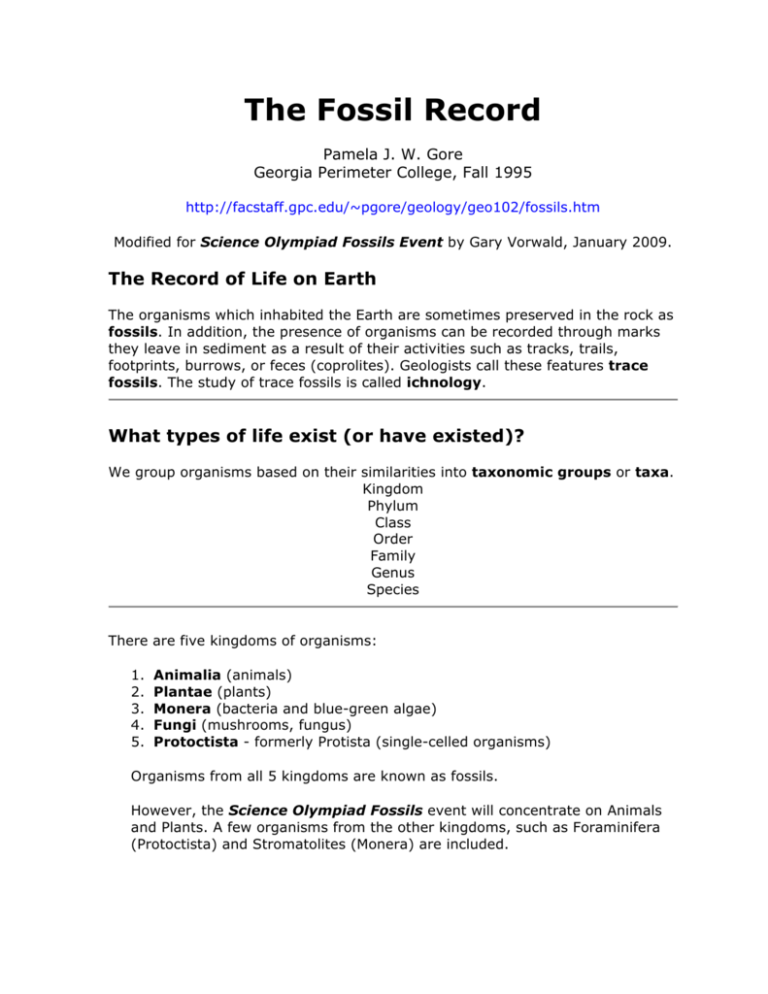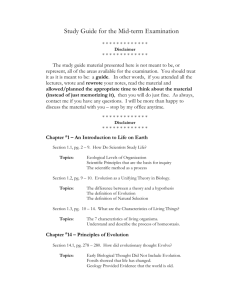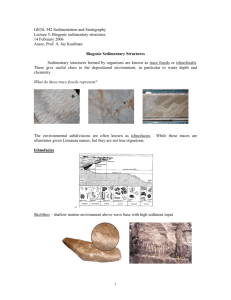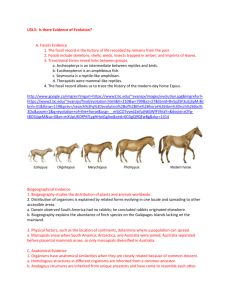The Fossil Record - modes of life
advertisement

The Fossil Record Pamela J. W. Gore Georgia Perimeter College, Fall 1995 http://facstaff.gpc.edu/~pgore/geology/geo102/fossils.htm Modified for Science Olympiad Fossils Event by Gary Vorwald, January 2009. The Record of Life on Earth The organisms which inhabited the Earth are sometimes preserved in the rock as fossils. In addition, the presence of organisms can be recorded through marks they leave in sediment as a result of their activities such as tracks, trails, footprints, burrows, or feces (coprolites). Geologists call these features trace fossils. The study of trace fossils is called ichnology. What types of life exist (or have existed)? We group organisms based on their similarities into taxonomic groups or taxa. Kingdom Phylum Class Order Family Genus Species There are five kingdoms of organisms: 1. 2. 3. 4. 5. Animalia (animals) Plantae (plants) Monera (bacteria and blue-green algae) Fungi (mushrooms, fungus) Protoctista - formerly Protista (single-celled organisms) Organisms from all 5 kingdoms are known as fossils. However, the Science Olympiad Fossils event will concentrate on Animals and Plants. A few organisms from the other kingdoms, such as Foraminifera (Protoctista) and Stromatolites (Monera) are included. How do organisms get preserved as fossils? Most fossils are the hard parts of organisms: • • • • bones teeth shells wood Soft parts are rarely preserved: • • • skin muscle internal organs To be preserved, an organism must be in an environment where it is protected from oxidation and bacterial decay. 1. Must be rapidly buried by sediment 2. Must be shielded from oxygen (anaerobic or anoxic conditions) Some rocks are made up almost entirely of an accumulation of organic remains or shells or other hard parts of organisms (coquina, fossiliferous limestone, chalk, diatomite, coal). In which environments are fossils most readily preserved? Environments covered by water; particularly environments with a high sedimentation rate or waters that lack oxygen. Examples: swamps, deep lakes, tar pits, oxygen-minimum zone in the oceans. What are the major animal groups? Animals can be grouped into the invertebrates (animals without backbones) and the vertebrates. There are more than 20 invertebrate Phyla, but the chief ones that are preserved as fossils include: 1. 2. 3. 4. 5. Phylum Porifera - the sponges Phylum Cnidaria (formerly Coelenterata) - the corals and jellyfish Phylum Bryozoa - the colonial moss animals Phylum Brachiopoda - the brachiopods or lamp shells Phylum Arthropoda - the insects, crabs, shrimp, lobsters, trilobites and eurypterids 6. Phylum Mollusca - the clams, snails, octopus, squid, nautilus, and ammonites 7. Phylum Echinodermata - the starfish, sand dollars, sea urchins, crinoids, and blastoids The vertebrates belong to Phylum Chordata (referring to the nerve chord that extends down the center of the spine). What can these fossils tell us about the past? The study of the interaction of ancient organisms with their environment is called paleoecology. In large part, paleoecology depends on comparisons of ancient organisms with living organisms. We use modern analogs to help us interpret something about the way in which the fossils lived and related to their environment. Fundamental concepts of ecology and paleoecology: Ecosystem - the organisms and their environment - the entire system of physical, chemical, and biological factors influencing organisms Habitat - the environment in which the organism lives Community - the association of several species of organisms in a particular habitat (the living part of the ecosystem) Niche - the way in which the organism lives - its role or lifestyle. Some organisms live on the land, and some live in the water. 1. Land-dwellers are called terrestrial organisms 2. Water-dwellers are called aquatic organisms 1. Marine (inhabit saline sea water) - salinity of sea water is about 34 - 36 parts per thousand total dissolved solids, or about 3.5% salt. 2. Non-marine (inhabit freshwater) - salinity of freshwater is about 1 part per thousand total dissolved solids, or about 0.1% salt. Includes rivers, freshwater lakes, springs, caves, wells, groundwater. 3. Brackish (inhabit water of intermediate salinity) - brackish water is a mixture of fresh water and sea water, and may be found in bays, deltas, lagoons, estuaries, harbors, etc. 4. Hypersaline - water of very high salinity, such as the Great Salt Lake, Dead Sea, and some tropical bays and lagoons with high evaporation rates. Very few fossils lived in this environment. Marine organisms inhabit the pelagic realm - all of the water overlying the ocean floor. It can be divided into: • • neritic zone (shallow marine) - overlying the continental shelves - from the low tide line to approximately 200 m (600 ft) oceanic zone - the deep ocean. Near the shore, organisms inhabit the littoral environment (the shoreline or tidal zone), which can be divided into: 1. supratidal (above the normal high tide line - usually high and dry) 2. intertidal (between the high and low tide lines - alternately wet and dry) 3. subtidal (below normal low tide line - usually under water) Terrestrial organisms may inhabit one of the following environments: 1. 2. 3. 4. Lacustrine - lakes and ponds Fluvial - rivers and streams Paludal - swamps Eolian (or aeolian) - deserts Modes of life Aquatic animals may have varying modes of life: • • • planktonic - small plants and animals that float, drift, or swim weakly o phytoplankton - plants and plant-like plankton, such as diatoms and coccolithophores o zooplankton - animals and animal-like plankton, such as foraminifera and radiolaria nektonic - swimming animals that live within the water column benthonic or benthic - bottom dwellers, whch may be either: o infaunal - living beneath the sediment surface o epifaunal - living on top of the sediment surface Bottom dwellers capable of movement are called vagile or vagrant. Bottom dwellers which do not move are called sessile. Nutrition Methods of obtaining nutrients: 1. Primary Producers - produce their own food through photosynthesis, and supply food and energy for other organisms. The groups that are producers include plants, algae, blue-green algae, and some protests. Stromatolites are some of the earliest producers that are found as fossils. 2. Consumers - cannot produce their own food and must eat. 1. Herbivores – consumers (heterotrophs) that eat plants 2. Carnivores – consumers (heterotrophs) that eat herbivores and other carnivores. One species eating another is called predation. 3. Other feeding modes which may fit into the above categories: 1. Parasites - derive nutrition from other organisms without killing them 2. Scavengers - derive nutrition from dead organisms 3. Suspension feeders - filter small food particles from the water 4. Deposit feeders or detritus feeders - injest sediment and extract small food particles 5. Grazers - scrape food from the substrate 6. Decomposers and Transformers - bacteria which break down organic matter converting it into a form which can be utilized by other organisms (nutrients)





